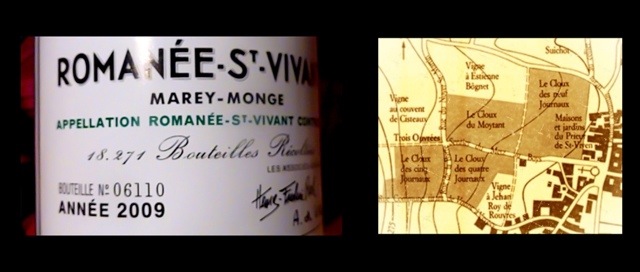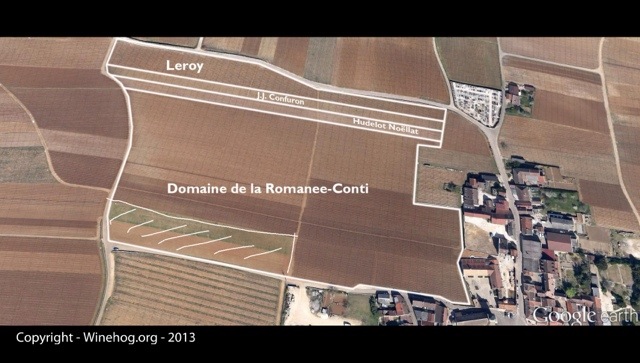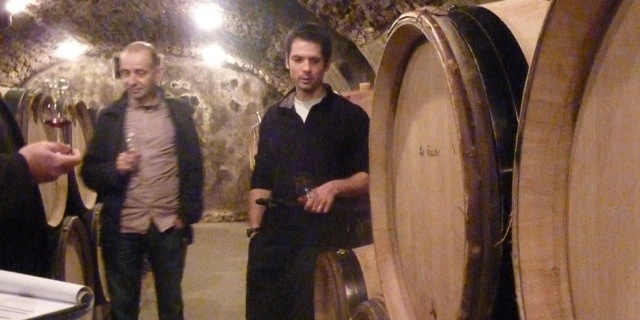I have recently worked on some articles about the great terroirs – starting with Romanee-Saint-Vivant. In this proces I sort of got caught up in the history of the Romanee-Saint-Vivant vineyard, thus also the history of DRC and the L’abbeye Saint-Vivant de Vergy – and wanted to explore this further.
I was therefore very exited when I got the opportunity to visit DRC on my March trip to Burgundy – the date 20th of March 2013 will be remembered.
Importance of history and preserving the lagacy of Saint-Vivant de Vergy
When I arrived at Domaine de la Romanee-Conti I was received by Jean-Charles Cuvelier, the estate director at DRC, who generously had prepared a fine program for our visit – with a special focus on the Romanee-Saint-Vivant vineyard.
When talking to Jean-Charles Cuvelier it becomes very clear that history plays a very strong roll in running and developing Domaine de la Romanee-Conti. All changes seems to be made with careful respect for the historic values, thus both keeping the legacy and still moving forward improving quality and the expression of the terroirs.
The history of some of the vineyards dates almost 1000 years back, and I must say I find it very fascinating to see how a lot of the vineyards, layed out by the monks L’abbeye Saint-Vivant de Vergy, still exists today. The names of the vineyards may have changed, but many roads and borders between the vineyards in Vosne are relatively unchanged – and some vineyards like the DRC section of Romanee-Saint-Vivant – have only changed owners two times during these 1000 years – indeed a historic place.
One can really appreciate why Aubert de Villaine has worked very hard to get the Burgundy vineyards recognized as UNESCO World Heritage – and been very active in conserving the historic landmarks connected to the vineyards.
Jean-Charles Cuvelier explained that Domaine de la Romanee-Conti have established a foundation Association de l’abbeye de Saint-Vivant – this foundation has acquired the old monestary L’abbeye Saint-Vivant de Vergy – the cradle of some of the greatest Burgundiean vineyards – with the purpose to save this historic landmark for the future generations.
With the history in mind – we turned to the vineyards and the wines.
Exploring Romanee-Saint-Vivant with Nicolas Jacob
Next stop was a small field trip in Romanee-Saint-Vivant with the Chef de Culture (vineyard manager), Nicolas Jacob, who is one of the key people behind the high quality at DRC.
As many Burgundy producers will tell you – the work in the vineyard is the foundation for all great wines. The work in the cellar can merely expose and present the qualities shaped by the terroir and the work in the vineyards.
Nicolas Jacob, who has been with DRC since 2006, is a very dedicated and intense young man, with a strong passion for his work. He explained in great detail, how they over the years have worked to improve the vineyards – especially focusing on work done in the Romanee-Saint-Vivant vineyard.
DRC took over the Romanee-Saint-Vivant vineyard in 1988 from the Marey-Monge family after renting it since 1966. Since 1988 they have worked very dedicatedly to improve quality and to realize the potential of this legendary vineyard.
An important part of this proces was to improve the quality of the vines in the RSV vineyard. Nicolas Jacob told us that they slowly but surely have removed the old high yielding clones, and replaced them with the lower yielding DRC “clones”.
Some of the old vines on Romanee-Saint-Vivant were according to Nicolas Jacob very productive with big grapes and potentially very high yields – yields well beyond 50 hectoliter per hectare were mentioned.
Some of these high yielding vines have now been grafted with the lower yielding DRC “clones”, thus using the old root as a base for the vine, while other vines have been replaced by new stocks.
The DRC “clones” used are based on selected material from the Romanee-Conti vineyard, they produce smaller grapes with a optimal balance between solid and liquid material, and with a more intense and complex aromatic profile1 The grating and replanting are done using a several of the DRC “clones” to ensure a aromatic diversity/complexity.
The grafting method were used in some plots – including the southeast corner of the vineyard – but some plots were not suited for grafting, and it was deemed nessesary to replace the roots.
All the wines in southwest corner of the DRC section of Romanee-Saint-Vivant have already been uprooted and replanted. This is a long proces – the first plot was cleared in 2000/2001, and then the plot laid fallow for some years and was replanted in 20051. The replanting proces is now continuing in the other uprooted plots in the southwest corner of the DRC section of Romanee-Saint-Vivant – see map below.
The production from these replanted plots will not be included in the DRC Romanee-Saint-Vivant before the vines reach a sufficient age – i.e. after two or three decades.This replacement of vines really show the DRC dedication to improve quality in the RSV vineyard – it’s not a free ride to exclude a quite substantial part of the vineyard from the production during the next 20 years.
There are constantly work to do in the vineyards, and Nicolas Jacob told us about several other large projects in La Tache and Grands Echezeaux that should ensure the high quality in these vineyards.
Tasting of the 2011s from Domaine de la Romanee-Conti
Next stop was a tasting of the 2011 vintage from DRC – Romanee-Saint-Vivant, Richebourg, La Tache and Romanee-Conti were available for tasting – the other wines were either bottled or prepared for botling.
First out we tasted the wine from two different casks of Romanee-Saint-Vivant – one sample was from a new oak barrel, while the other wine came from a previously used “old” barrel.
The RSV without new oak was slightly more closed (reduction) than the wine from new oak, but both showed vibrant red berry fruit, a lovely crisp minerality and very fine energy. The new oak add some weight and body to the wine … and seems to enhance the expression of the wine at this point.
Tasting these two wines gave an important insight in the effects of the oak used by DRC – in my view a quite important factor behind the qualities of these wines.
The oak used at Domaine de la Romanee-Conti seems very discrete and while very important to the wine it doesn’t add any distingt or dominant flavors to the wine – the oak is seen more as a catalyst that enhances and refine the flavors allready found in the wine – offering additional depth, body and focus. DRC mainly uses casks from Tonnellerie Francois Freres – made from oak taken from the Foret de Troncais in Allier and Foret des Bertranges in Nievre1
The tasting notes for the 2011s are found via the links below – the note for the RSV is based on the tasting of the wine from the new barrel.
Tasting notes for the 2011 DRC wines
- Domaine de la Romanee-Conti, La Tache 2011
- Domaine de la Romanee-Conti, Richebourg 2011
- Domaine de la Romanee-Conti, Romanee-Conti 2011
- Domaine de la Romanee-Conti, Romanee-Saint-Vivant 2011
Tasting of older two older DRC wines
Last stop in our program was at the large tasting table in the bottle cellar of DRC. Here we tasted two matured wines – the Richebourg 2004 and the Batard Montrachet 2000.
The Richebourg 2004 was very open and expressive with loads of red fruit and sous-bois in he nose. The palate offered lovely cool fruit – balanced and refined – without the green notes found in some 2004s – a fine wine indeed.
The Batard-Montrachet 2000 was fantastic offering layers of matured fruit, puity, depth and complexity. A outstanding wine by any standard – sadly it’s not commercially availible.
Tasting notes for the last two wines will follow shortly.
References & Sources:
- Gert Crum, Domaine de la Romanee-Conti (2012)
Special thanks to Nicolas Jacob and Jean-Charles Cuvelier at DRC for the helpful informations and comments.
Related articles
- Vins d’Emotion from Vosne-Romanée and Flagey-Echezeaux (update)To simplify your search for emotional wines, I have decided to compile a list of the top emotional producers in each appellation. Comments and thoughts The list contains producers that regularly score an emotional rating, and they are ranked in three levels. I hope this proves useful; here we go! Note that any wines marked with brackets ...
- To Passion in 2022!I have made it my “calling” to discover emotional wines for you to seek out and enjoy in your personal hedonistic quest. These vins d’émotion have nerve, tension, and energy behind their hedonistic intensity. I hope they evoke your passion: the passion to explore and the passion to have another glass, drink another bottle, then ...
- Terroir Insight: Domaine de la Romanée-Conti Corton-CharlemagneTime is flying. There have already been 11 vintages since Domaine de la Romanée-Conti took on the making of a red Corton in 2009, and now the legendary estate is tackling another of Burgundy’s greats: Corton-Charlemagne. Its opportunity comes, of course, via the vineyards of the historic Bonneau du Martray (BdM) estate in Pernand-Vergeleses: Domaine de ...
- Terroir Insight: Domaine de la Romanée-Conti Bâtard-MontrachetA legendary, yet somehow unknown, wine; a wine not sold, but served on occasion; a wine above commercial interest; and a hedonistic blessing for a lucky few. the Domaine de la Romanée-Conti plot I am of course talking about the Bâtard-Montrachet from Domaine de la Romanée-Conti, a wine served only – or should I say mainly – ...
- Terroir View: Domaine de la Romanée-Conti , “Vosne-Romanée Les Petits Monts”Vosne-Romanée Les Petits-Monts is a delightful vineyard, and one of the gems of Vosne-Romanée and is getting more and more fame and attraction. One plot is however both relatively unknown but also very well located indeed. I am of cause talking about the plot owned by Domaine de la Romanée-Conti .. Vosne-Romanée Les Petits-Monts Petits-Monts is a ...




 - A true vin d’émotion – a Burgundy of passion
- A true vin d’émotion – a Burgundy of passion - A truly hedonistic wine – lively and enjoyable
- A truly hedonistic wine – lively and enjoyable - A vivacious wine for pure indulgance
- A vivacious wine for pure indulgance - A Vin Vif - fresh, energetic and with a light appearance
- A Vin Vif - fresh, energetic and with a light appearance